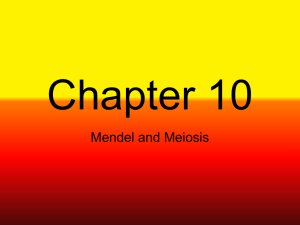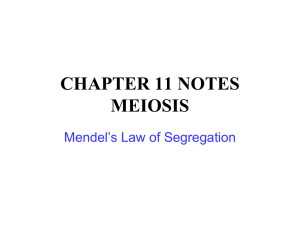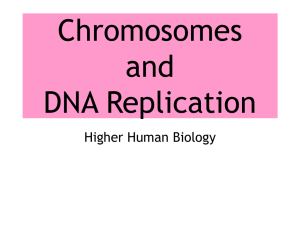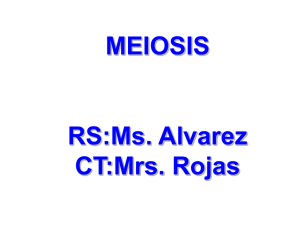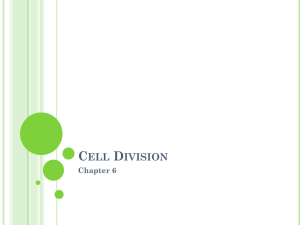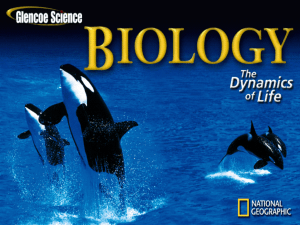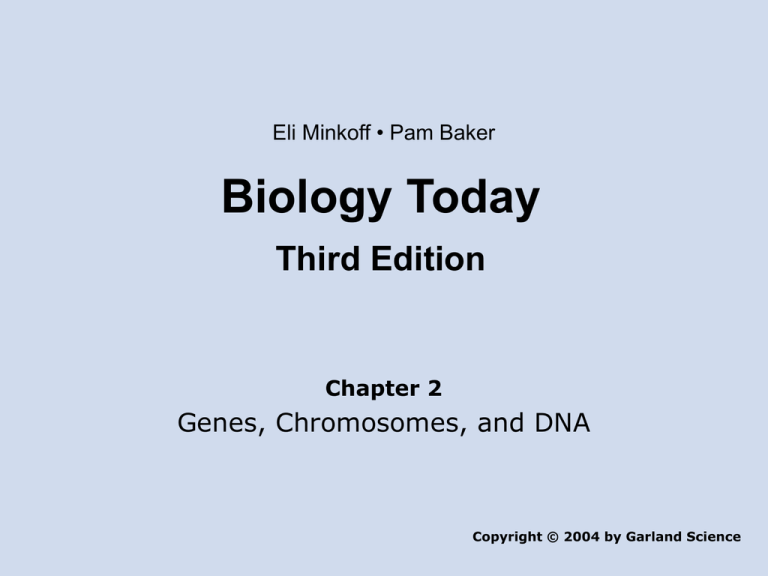
Eli Minkoff • Pam Baker
Biology Today
Third Edition
Chapter 2
Genes, Chromosomes, and DNA
Copyright © 2004 by Garland Science
LEARNING OBJECTIVES
•Know that Gregor Mendel is the father of modern genetics.
•Define “true-breeding,” “P generation,” “F1 generation,” F1
generation.”
•Define dominant and recessive, homozygous and heterozygous,
genotype and phenotype, homologous chromosomes, diploid,
haploid.
•Be able to use a Punnett square to visualize the outcome of a
genetic cross.
•Be able to state Mendel's two laws of heredity.
•Realize that genes are located along chromosomes.
•Understand that sexual reproduction and meiosis increases the
diversity in a species
•Know how many chromosomes are in normal human cells and that
nondisjunction leads to trisomy and aneuploidy.
Figure 2.1
Mendel and the Garden Pea
Heredity is the passing along of traits from one generation to the next.
Genetics is the study of heredity.
Mendel contributed to the understanding of genetics in the 1800s by
counting numbers of offspring in crosses in pea plants.
Mendel’s Experimental System: The Garden Pea
Mendel used the garden pea because of the varieties available.
peas are small, grow and reproduce quickly, and the flowers self-pollina
Mendel’s Experimental Design
Mendel began his crosses with pure-breeding varieties
that contained distinct phenotypes.
The first generation of crosses is the P or parental generation;
their offspring are the F1 generation or first filial generation.
Offspring of the F1 generation comprise the F2 generation.
Figure 2.2
The F1 Generation-
Monohybrid cross-2 purebreeding phenotypes RR X rr
were cross fertilized.
F1 heterozygotes exhibited dominant traitand the trait not expressed
was recessive.
The F2 Generation
F1 plants self-fertilized, F2 a 3:1 dominant to recessive phenotype
A testcross of F2 generation. found a 1:2:1 genotypic ratio.
Figure 2.3
Mendel’s Results
• Monohybrid crosses between 2
purebreeding parents the dominant trait
only appeared in the F1 generation.
• The F2 generation the recessive trait
reappeared.
Testcross
• the genotype of an individual expressing
a dominant trait, he did a testcross by
crossing the individual with a
homozygous recessive for the trait.
• Testcrosses are used to determine the
genotype of an individual who
expresses the dominant trait but may be
heterozygous or homozygous.
Mendel’s First Law
• Law of segregation-monohybrid cross;
phenotypic ratio 3:1, genotypic ratio
1:2:1
Mendel’s Second Law
• Law of Independent Assortmentdihybrid cross; phenotypic ratio 9:3:3:1
Punnett Square
• The shorthand method for determining
the ratio among offspring from a
particular cross is called a Punnett
Square.
• The allele present in the male and
female haploid gametes are
represented and diploid offspring from
fertilization appear in squares,
Figure 2.4
How Genes Influence Traits
From DNA to Protein
1. DNA is transcribed into RNA in the nucleus.
2. RNA is translated into protein on ribosomes in the cytoplasm.
How Proteins Determine the Phenotype
1. The specific sequence of amino acids determines a protein’s function,
specifying phenotype
Figure 2.5
Chromosomes
• Structures visible during cell division
where the genetic material-DNA-resides
• Homologous chromosomes – alike in
size, structure, and genes they carry
• One member of each pair of homologs
is received from each haploid gamete at
fertilization.
Figure 2.6
Figure 2.7
Germ-Line Tissues
Cells that produce gametes are called germ-line tissues.
Germ-line cells will undergo meiosis to produce haploid gametes.
The Stages of Meiosis
The formation of haploid gametes
•
•
•
•
Replication of the genetic material occurs prior to
meiosis
Meiosis has two divisions: meiosis I and meiosis II
Crossing over occurs during prophase I of meiosis I
when pieces of nonsister chromatids exchange
places to promote new genetic combinations in the
offspring.
Nonsister chromatids are replicated chromosomes,
held together and derived from a different member
of the homologous pair
Meiosis I and II
Formation of haploid gametes
• Further genetic diversity is achieved by the
independent orientation of replicated
homologous chromosomes at the metaphase
I plate
• Meiosis II results in four haploid (1N)
gametes.
• Genetic diversity is also achieved at
fertilization-which of the diverse gametes
fertilize
Figure 2.8
Figure 2.8 (1)
Figure 2.8 (2)
Figure 2.9
Figure 2.9 (1)
Figure 2.9 (2)
Figure 2.10
Figure 2.11
How Meiosis Differs From Mitosis
Meiosis has three unique features:
1. Synapsis and cross-over
The process of pairing throughout the length of the
homologous chromosomes and exchanging genetic
fragments is called crossing-over
2. Reduction Division
Since DNA only replicates once, before meiosis I, the two
divisions result in halving the chromosome number in the
daughter cells (gametes) which are then haploid.
3. Fertilization
The diploid number is restored at fertilization.
Human Chromosomes
• Humans have 23 pairs, or 46, chromosomes
that vary by size, shape, and appearance.
• Photographing the chromosomes produces a
karyotype.
• Nondisjunction is the unequal separation of
chromosomes
• Trisomy is having an extra copy of a
chromosome, the lack of one is monosomy
and usually lethal.
Figure 2.12
Sex Determination
• The 23rd pair of chromosomes are
sex chromosomes; the others are
somatic chromosomes
• Females are XX
• Males are Xy
• The Y must have active genes to
determine maleness
Figure 2.13
Figure 2.14
Figure 2.15
Figure 2.16
Figure 2.16 (1)
Figure 2.16 (2)
Figure 2.16 (3)
Figure 2.17 (1)
Figure 2.17 (2)
The Griffith Experiment
•By experimenting with Streptococcus pneumoniae, he found
that the virulent strain’s polysaccharide coat was necessary
for infection.
•He experimented further and found that the information
specifying the polysaccharide coat could be passed from
dead, virulent bacteria to coatless,nonvirulent strains.
•Hereditary information could thus be passed from dead cells
to live ones, transforming them.
•The hereditary information was later determined to be DNA
Figure 2.18
From Genotype to Phenotype
How Genes Influence Traits
From DNA to Protein
1. The genetic code in DNA is transcribed into RNA in the nucleus.
2. RNA is translated into protein on ribosomes in the cytoplasm.
3. A protein is a specific sequence of amino acids determined the
genetic code
How Proteins Determine the Phenotype
The specific sequence of amino acids determines a protein’s function,
thus specifying phenotype
Structure of DNA
• Nucleotides: consist of
a phosphate, sugar and
one of 4 possible bases.
• The bases are Adenine,
Thymine, Guanine and
Cytosine
Figure 2.20
Figure 2.20a
Figure 2.20b
How the DNA Molecule Copies Itself
The Double Helix
•DNA molecule consists of two strands
•Each individual strand of a DNA molecule is complementary
to its opposite strand
•Base Pairing Rule: The base A always bonds to T
and G to C.
•If one chain has the bases ATTGCAT, its partner will have
the complementary sequence of TAACGTA.
ATTGCAT
TAACGTA
The 2 complementary Strands of DNA separate and serve as a
template for the positioning of nucleotides in the new strand
according to base pairing
Figure 2.21
Figure 2.22
Figure 2.22a
Figure 2.22b
Figure 2.22c
Figure 2.22d





